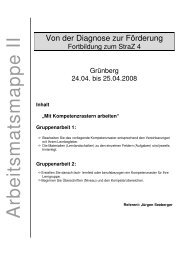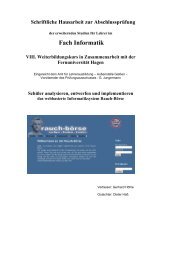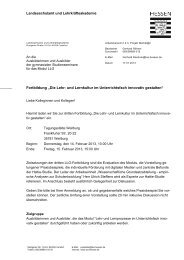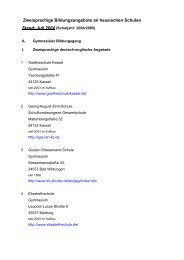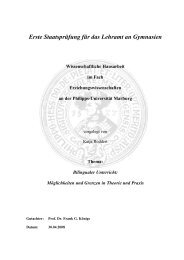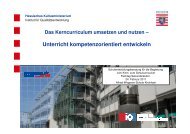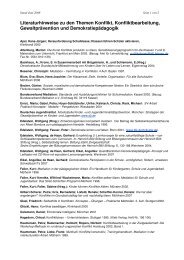PROFILING EUROPEAN CLIL CLASSROOMS
PROFILING EUROPEAN CLIL CLASSROOMS
PROFILING EUROPEAN CLIL CLASSROOMS
Create successful ePaper yourself
Turn your PDF publications into a flip-book with our unique Google optimized e-Paper software.
The Need for Research on <strong>CLIL</strong> in Europe<br />
Kees de Bot<br />
Katholieke Universiteit Nijmegen<br />
Profiling European <strong>CLIL</strong> Classrooms is an important milestone in the development of<br />
<strong>CLIL</strong> in the European context. The political climate for such an approach on a larger<br />
scale also seems to be favourable. Nevertheless, there is still a lot we need to learn in<br />
order to fully realise the potential of <strong>CLIL</strong>.<br />
In the recent past a number of research projects have been carried out to establish the<br />
effectiveness of the <strong>CLIL</strong> approach. The results of such research, particularly in the<br />
Netherlands and Germany, suggest that some forms of <strong>CLIL</strong> enhance the effectiveness<br />
of language learning and teaching. Any research in this field requires thorough and<br />
often inter-disciplinary analysis. In addition, research issues are more clearly understood<br />
by a wider audience if an overall picture of an innovation as complex as <strong>CLIL</strong> is<br />
available.<br />
The analysis of <strong>CLIL</strong> characteristics presented in Profiling European <strong>CLIL</strong> Classrooms is<br />
a step forward towards development of a more comprehensive understanding of <strong>CLIL</strong><br />
in its various forms. This book focuses on nine factors linked to implementation: agerange,<br />
sociolinguistic environment, exposure, target language, teachers, discourse<br />
type, trans-languaging, subject appropriacy, and content-language ratio. These are<br />
all variables that contribute to the character of any specific form of <strong>CLIL</strong>.<br />
The achievements of this type of publication can facilitate our need to move forward in<br />
our understanding of the impact of <strong>CLIL</strong>. In the field of applied linguistics, many of<br />
these issues are given attention, but mostly as one or two factors in isolation from<br />
others, and not usually aimed at <strong>CLIL</strong>. Analysing the consequences of all these factors<br />
and their interactions is a complex process. A series of interrelated research projects<br />
which examine some of these factors in situ could be one step in collecting quantifiable<br />
and relevant data which gives substance to any discussion about the merits or problems<br />
arising from an educational approach such as <strong>CLIL</strong>.<br />
It is unlikely that any single European organisation would be able to carry out the scale<br />
of research we now need without institutional collaboration and teamwork. This<br />
cooperation would need to be trans-national to represent at least some of the very<br />
different European situations in which <strong>CLIL</strong> is implemented. It is understanding <strong>CLIL</strong>,<br />
its challenges and outcomes, at the local level that enables us to substantiate and<br />
otherwise provide evidence for its value in general.<br />
This publication, and the accompanying <strong>CLIL</strong> Compendium Internet site, is the result<br />
of a low budget international collaborative project. The outcomes envisaged by the<br />
team members were, from the outset, modest. They set out to build an inclusive<br />
description of <strong>CLIL</strong> and produce this in a reader-friendly format, and this they have<br />
achieved. As a result, Profiling European <strong>CLIL</strong> Classrooms will have some impact on<br />
the research agenda for the years to come.<br />
Kees de Bot<br />
12



